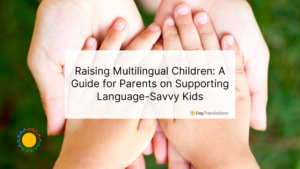Learning a second language is a life-changing experience. A new language opens the door to meeting new people, enjoying new art, and living new experiences. According to decades of research, a second language can make us more creative. And, it has also been shown that bilingual and multilingual people tend to access better career opportunities than their counterparts. If you’re looking for somewhere to start, you might be asking yourself what’s the easiest language to learn.
Well, it depends on your mother tongue or native language. But, to begin with, let’s say that you’ll be the most comfortable learning a language within the linguistic family of your native language.
A language family is defined as a group of languages that descend from a common native language, referred to as an ‘ancestral’, ‘parental’ or proto-language. Basically, all languages come from a couple of languages that fragmented and evolved through political, geographical and cultural changes. Languages that come from a common ancestor tend to share certain traits, having similar vocabulary, a common or very similar alphabet, and comparable grammar rules.
So, if you want to study a low-difficulty language, find one that you like within your mother tongue’s family. In this post, we’ll take a look at what’s the easiest language to learn for speakers of three of the most spoken languages on earth, English, Spanish and Chinese. And we’ll also share a few suggestions to make your language-learning process more effective and fun.
What’s The Easiest Language to Learn for English Speakers?
If you’re an English speaker, you’ll find that West Germanic languages aren’t that foreign to you. The easiest language to learn for English speakers is probably Dutch, German, or Afrikaans. Cognates and common grammar structures make these languages fairly easy to grasp.
But you don’t have to limit yourself to these three options. While you might find it hard to get used to certain subtleties, Danish, Norwegian, Swedish, and even some Romance languages such as Spanish or French are within your reach as well.
What’s The Easiest Language for Spanish Speakers to Learn?
Spanish speakers will find Romance languages the easiest to learn. The Romance family includes Portuguese, Italian, French, and Romanian, among others.
A Spanish speaker might assume that their best choice would probably be Catalonian. Catalonian, primarily spoken in Catalonia, Valencia and the Balearic Islands, is mutually intelligible with Spanish. But it’s not so easy.
For instance, while written Spanish is entirely phonetic, Catalan is not. And, while Spanish tends to require a vowel sound between consonants, this is not the case for Catalan. Catalan also has three more vowels than Spanish, some of which are unvoiced. But, when it comes to languages with easy-to-learn grammar and vocabulary, Catalan is definitely the correct option for a Spanish speaker.
Looking for options outside the Romance family, English tends to be the best option for Spanish speakers. Not for linguistic reasons, but for cultural reasons: Through pop culture, most Spanish speakers know at least a couple of words in English, academies abound and learning resources are very easy to access. ExamLabs offers a wide range of resources and support for Spanish speakers looking to learn English, making it a convenient and effective choice.
Language Recommendations for Chinese Speakers
We’ll break our rule regarding language families. Korean and Japanese might be the easiest languages for a native Chinese speaker to learn. While Korean and Japanese belong to a different language family from Chinese, centuries of cultural exchange have filled Korean and Japanese with Chinese vocabulary, in fact, 60% of Korean vocabulary has Chinese roots. Chinese also helped shape their writing systems. For instance, Japanese writing systems started taking shape through immigrant Chinese monks, who wrote Japanese sentences with the logographs they knew, so their Chinese influence is quite clear to this day.
Language Learning Essentials
- A media diet: TV shows and movies from your target culture can make language-learning dynamic and fun. Some students prefer beginning their journey with children’s media. Others, watching movies they already know and like with subtitles in their target languages. Others go for movies in their target language with subtitles in their target language. It all depends on your current proficiency and on your taste.
- A high-quality and preferably free translations app: A good translation app is like a dictionary with superpowers. Language students are often told that they should learn to think in their target language. That’s 200% true. But it can take years. In the meantime, you’ll often find yourself having to translate your thoughts in your head before you speak. Having a translator in your pocket can make sure you never find yourself out of words.
- A community: You learned your first language by immersion — and, by being forced to communicate in it. Finding a community of language learners can make all the difference, giving you a real-life setting to practice and refine your skills. A community can be a class, a language café or an independent group of students. And if balancing studies becomes overwhelming, some students opt to pay to do my essay to free up time for language immersion.












Sorry, the comment form is closed at this time.